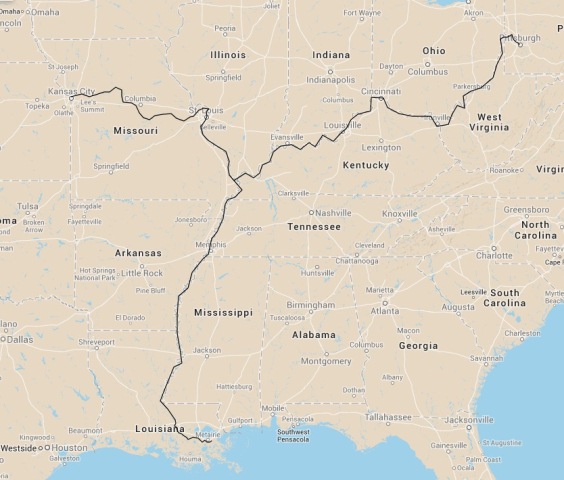
i. Voyage dans l'Amérique septentrionale
Voyage dans l'Amérique septentrionale: ou description des pays arrosés par le Mississippi, l'Ohio, le Missouri et autres rivières affluentes, observations exactes sur le cours et les sondes de ces rivières, sur les villes, villages, hameaux et fermes de cette partie du nouveau-monde, suivi de remarques philosophiques, politiques, militaires et commerciales, et d'un projet de lignes frontières et de limites générales, avec un atlas de 36 cartes, plans, vues et figures.
By Georges-Henri-Victor Collot.
Atlas principally engraved by Jean Baptiste Pierre Tardieu.
Paris: Chez Arthus Bertrand, Libraire, Rue Hautefeuille, No. 23, 1826.
2 volumes, 22 cm (8vo) + 1 atlas (36 leaves of plates (11 folded); illustrations, maps, portraits; 36 cm) -- Written in French; legends and cartouches of atlas are in English. -- Signatures: Vol. 1: 1-26⁸; v. 2: 1-26⁸ 27⁶ -- Atlas illustrations are black-and-white line engravings. -- Green leather spine and cornerpieces with marbled cover boards; gilt lettering and red and gilt decoration on spine. -- Library catalog record.
Click here for volume 1 -- volume 2 -- atlas.
Collot was 46 years old and a general in the French army when he undertook his expedition on the Ohio, Missouri, and Mississippi Rivers in 1796. The Indiana and Illinois territories along the Ohio River were under the control of the United States, and the English controlled the areas to the north in Canada. The Louisiana territory was under Spanish rule. All three countries were suspicious of Collot's activities. They believed he was a French spy. Perhaps he was.
Collot began his trip in Philadelphia. In St. Louis he became apprised of threats of detention by the American and Spanish governments and rumors that the English were planning his assassination by Indians. He fled down the Mississippi into the lower part of the Louisiana territory governed by Francisco Luis Héctor, barón de Carondelet. Collot claimed to uncover an English conspiracy planning a coordinated attack on upper and lower Louisiana and warned various Spanish commanders. This did not assuage Governor Carondelet's suspicions, and he continued to keep Collot under surveillance.
Collot's adjutant General Warin was attacked by Chickasaw Indians at the junction of the Arkansas and White Rivers, receiving a hatchet blow to the chest. Warin and Collot were separated at the time. Collot believed the Indians were assassins who had followed them from Illinois, and that they had mistaken Warin for Collot.
Collot continued down the Mississippi River, exploring its tributaries and noting various forts along the way. Upon reaching the sugar plantations in the bayous approaching New Orleans, Collot and Warin were arrested by Major Guilmard on October 27th at the residence of Etienne de Boré, the French planter who pioneered sugar granulation in Louisiana. Collot claimed that they were arrested moments before Warin was to set out to present their passports to Governor Carondelet.
Collot and Warin were held at Fort St. Charles, their baggage confiscated and searched before being returned to them. Warin, still ill from his Indian attack, was relocated to an inn and subsequently died. Governor Carondelet transferred Collot to house arrest until Collot finally boarded the ship Iphengenia, headed for Philadelphia, on November 22nd.
---Written by Mary Z. Rose
References consulted for exhibition text:
Collot, Victor. A Journey in North America. Paris: A. Bertrand, 1826. Online access is unrestricted.
Cruzat, Heloise Hulse. "General Collot's Reconnoitering Trip Down the Mississippi and His Arrest in New Orleans in 1796, by Order of the Baron de Carondelet, Governor of Louisiana." Louisiana Historical Quarterly. 1.4 (1917): 303-320.